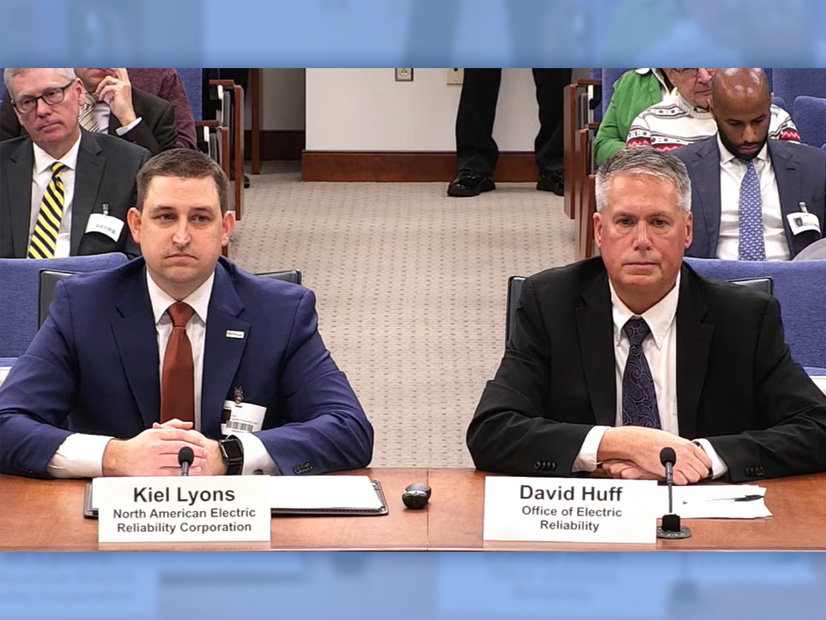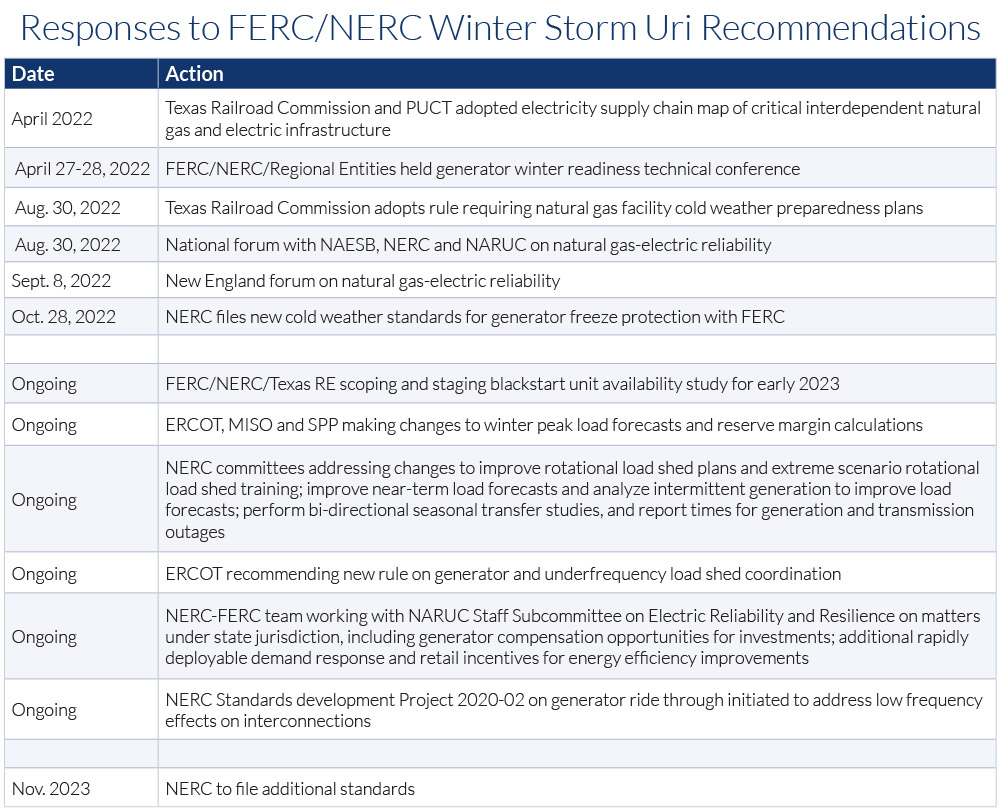
FERC Chairman Richard Glick said Thursday that regulators and industry have made “remarkable” progress on recommendations in response to the February 2021 winter storm but that he isn’t ready to declare “Mission Accomplished.”
FERC and NERC staffers told the commission during a presentation at the monthly open meeting that progress has been made on all 28 recommendations in the FERC-NERC report issued in November 2021, thanks to efforts by the ERO, Texas Railroad Commission (RRC), North American Energy Standards Board (NAESB) and National Association of Regulatory Utility Commissioners (NARUC), as well as ERCOT, MISO and SPP.
Among the responses cited by David Huff, of FERC’s Office of Electric Reliability, and Kiel Lyons, of NERC, were:
- ERCOT’s inclusion of the February 2021 extreme winter weather conditions in calculating its base peak demand forecast for its 2022/23 Winter Seasonal Assessment; SPP incorporating a 90-10 load forecast and including limited fuel supply scenarios in its 2022/23 Winter Assessment; and MISO’s move to a seasonal capacity construct in winter 2023/24.
- the Public Utility Commission of Texas’ work with the RRC to adopt an electric supply chain map of critical interdependent natural gas and electric infrastructure, which identify types of natural gas infrastructure to prioritize for protection from firm load sheds.
- the PUC’s actions advancing new transmission beyond the Texas Interconnection’s current 1,220 MW of asynchronous DC ties to SPP (820 MW) and Mexico (400 MW). Southern Cross Transmission would provide a 2,000-MW link between the Texas Interconnection and the SERC Reliability region, while Grid United’s Pecos West project would add a 1,500-MW HVDC line between ERCOT’s West Texas region and El Paso in WECC territory (Project 53758). (See ERCOT Board Gives Southern Cross Project a Boost.) The FERC-NERC report said such links would increase the region’s import capacity during emergencies and improve its black start capabilities.
- NERC’s September 2022 cold weather preparations alert and the ERO’s cold weather preparedness webinars and workshops, and the incorporation of more comprehensive extreme weather scenarios and energy assessments in NERC’s 2022/23 Winter Reliability Assessment. NERC’s Reliability and Security Technical Committee will hold a summit Jan. 31-Feb. 2 on the progress made toward implementing the recommendations.
Fourth Winter Event in 10 Years
The storm marked the largest firm load shed event in U.S. history, at 23,418 MW, and was the fourth event in 10 years in which reliability was jeopardized by unplanned generating unit outages in cold weather.
NERC initiated Project 2019-06 in response to a January 2018 cold weather event, when below-average temperatures resulted in 183 generating units in SPP, MISO, the Tennessee Valley Authority and SERC experiencing either an outage or a failure to start over a five-day period.
 FERC/NERC
FERC/NERC
The rules — which require generator owners (GOs) to protect their units from freezing, and transmission operators (TOPs) and balancing authorities to revise their emergency operating plans — were approved by FERC in August 2021, several months after the February 2021 storm. (See FERC Approves Cold Weather Standards.) They don’t become effective until April 1, 2023 — too late for this winter.
Glick recalled that he and NERC CEO Jim Robb vowed that the findings on the storm would result in significant change and not “gather dust” like prior reports. (See FERC, NERC Release Final Texas Storm Report.)
“I think it’s remarkable when you think about the short time period [since the report] that we’ve made progress on all 28 recommendations,” Glick said. “Now, I want to make it clear: We’re not hanging the ‘Mission Accomplished’ banner. There’s still a lot more that needs to be done here … before we can feel more comfortable about where we stand in terms of Texas, but also elsewhere, in terms of preparedness for significant winter storms.”
‘Heavy Lift’
In late October, NERC filed for FERC approval of new reliability standards concerning freeze protection for generation and natural gas facilities impacting the bulk power system (RD23-1).
NERC said proposed reliability standards — EOP-012-1 (Extreme Cold Weather Preparedness and Operations) and EOP-011-3 (Emergency Operations) — build on the first round of cold weather standards approved by FERC in 2021, creating “a more comprehensive framework of requirements” on generator preparedness for cold weather operations and requiring TOPs to minimize the use of manual load sheds that could exacerbate emergency conditions and threaten reliability.
The report prompted Project 2021-07 (Extreme Cold Weather Grid Operations, Preparedness, and Coordination), which broke the recommendations into two phases, tackling four of them in the standards approved by NERC’s Board of Trustees in October and pending FERC approval. (See NERC Board Approves New Cold Weather Standards.)
SPP attorney Matthew Harward, the head of the standards drafting team, provided an update on the project at the Standards Committee meeting Dec. 13.
The recommendations in the second phase “are basically further identification of cold weather critical components and systems, and then the implementation of freeze-protection measures on each of those elements identified,” Harward said. “Those are GO requirements, and additional GO requirements that will be in the standard are that they must account for the effects of precipitation and wind when determining their lowest temperature [at which they are] able to operate.
“There are quite a few that will impact the BA and the data specifications between the BA, the RC [reliability coordinator], the TOP and the GO. A big one of that is that BA operating plans will need to prohibit critical natural gas infrastructure loads from participating in demand response programs,” he added.
The BAs, TOPs, RCs and transmission providers also will have new rules concerning how critical natural gas infrastructure is involved in manual and automatic load shedding.
“So we have some heavy lifts that the team is dealing with. We have a lot of participation from industry … which we feel is a good thing, but it also makes up for a lot of conversation; there’s a lot of opinions out there.”
Harward said his team is confident it can complete phase 2 and make its recommendations to the board by Sept. 30, 2023.
“It’s going to be a little more challenging than maybe we initially thought, but we are definitely up for the challenge,” he said.


